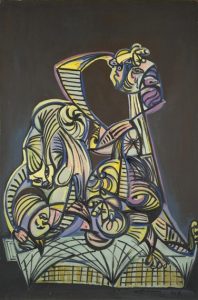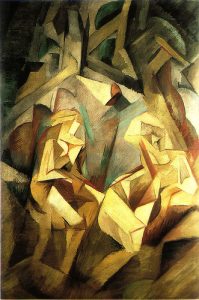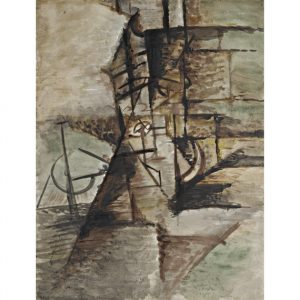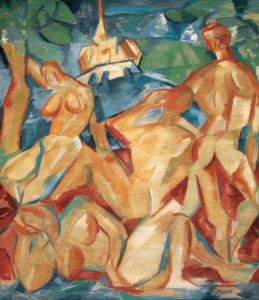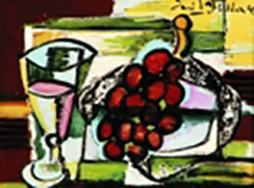Emil Filla was born on the 4th of April in 1882 in Chropyne, Moravia.
1882 - 1953
Emil Filla
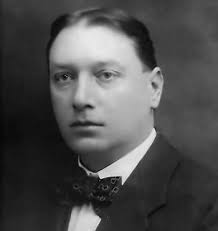
description
Czech teacher, graphic artist and sculptor, one of the largest and brightest representatives of Cubism in his country. The editor of art magazines and an art theorist. Having survived concentration camps, after World War II, he became the first author whose personal exhibition was organized by the official Association of Czech Artists. Filla was engaged in teaching activities, but could not participate in exhibitions, because his works did not belong to Socialist realism. In co-authorship with Otto Guthfreind, the Czech artist created Cubist sculptures, considered to be the very first in the history of fine art. Later he applied this style in decorative and applied art, including painting on glass.
Although Cubist architecture became a real phenomenon in the Czech Republic, thanks to the work of such masters as Emil Filla, the legacy in painting became a significant and important part of the European contemporary art. The artist left a significant creative legacy, including a large number of theoretical essays on art. In 1998, he was posthumously awarded The Order of Tomáš Garrigue Masaryk of the 3rd degree for his services to the country.
Key ideas:
– In the works of Emil Filla of his early period, the combination of German expressionism and the trends of emerging Cubism is clearly traced. Constant searches led to the inconsistency of the artist’s own manner. Specialists define his style as Cubo-Expressionism with the obvious influence of El Greco, the artist of the Spanish Baroque era.
– Later, a growing number of paintings were created in absolutely cubistic frameworks. Those were mostly still lifes with a variety of unusual combinations of different objects.
– Elements of the collage were sometimes used in still lifes: fragments of newspaper pages or labels were placed next to the oil paint on the plane. Thus, Filla developed the genre of art installation. However, the artist did not refuse from figurative painting with deep philosophical content and portraits with psychological overtones (“Smoker”, “Woman”).
– The main direction of his mature works was the desire to split objects into geometricized conditional forms to show the depicted object from different angles. Filla considered works composed of cubic figures richer in impressions for the viewer and more expressive.
– In the 1920s, the master developed his version of Synthetic Cubism, and later used some techniques of surreal painting, but did not become a surrealist.
– In response to the spread of fascism, being inspired by the Scythian reliefs, the artist created some paintings in the 1930s. He depicted the battle of a man with wild beasts or fierce battles between different animals in various techniques.
1882
1903
1907 - 1908
1909
1911
1913 - 1919
1930
1940
1953
The birth of the artist
Began to study at the Prague Art Academy
Began to study at the Prague Art Academy. However, three years later, left classes with a number of fellow students because of the conservatism of teaching methods. In many ways, the reason for this decision was the exhibition of works by Edvard Munch, held in Prague in 1905.
«Osma»
Joined the group “Osma” (“Eight”), got carried away by Impressionism and participated with paintings of this style in the exhibitions of this association. Among the exhibited works, there were the series “The Reader of Dostoevsky” and “The Chess Players.”
The artist was simultaneously engaged in sculpture and figurative painting
Became a member of the large creative association of Czech artists, The Association named after Manes, in which, with a break in 1911-1914, he was until the end of life. The features of Cubism and elements of the collage appear in his works (especially in the genre of still life). That was the result of learning works by Picasso, Gris and Braque. The artist was simultaneously engaged in sculpture and figurative painting.
He founded the association of artists-cubists
Having come into conflict with the official Association of Czech Artists, he published art criticism articles about the value of Cubism and the genius of its chief creator Pablo Picasso in his magazine «Volné směry». He founded the association of artists-cubists “Skupina výtvarných umělců” (“Group of Visual Artists”), which included not only artists and sculptors, but also architects, writers (for example, Karel Capek), musicians and art theorists. The group published its magazine “Umělecký měsíčník”.
After the war, he worked as an adviser-ambassador in the Netherlands
Along with his friends, Benes, Gutfreund, Janak, he participated in the First German Autumn Salon in Berlin. Traveled to Paris, married Hane Craikova and moved with her to Amsterdam, where he joined the resistance group that was against the Habsburgs. In Holland, he co-authored with O. Gutfreund, the creator of the world’s first Cubist sculptures “Mafia”. Participated in the Czech liberation movement, but did not stop painting. After the war, he worked as an adviser-ambassador in the Netherlands. After returning to the capital of the Czech Republic he worked in the Ministry of Foreign Affairs.
«Poesie»
Was a participant of “Poesie” – an international exhibition in Prague, which brought Surrealism to the Czech culture. The artist participated in activities to prevent the spread of Nazi ideas, which was reflected in his work.
On the first day of the Second World War, the artist was arrested
On the first day of the Second World War, the artist was arrested along with a friend of the Czech artist and writer Josef Czapek (brother of Capek Chapek) and spent several years in a concentration camp. After liberation, he taught painting at the Prague Academy of Arts, Architecture and Design. In 1945, “Manes” dedicated his first postwar exhibition to the works of Filla. Later, the artist’s works were allowed to be exhibited not at all exhibitions, because they did not meet the requirements of socialist realism. Nevertheless, the government gave him an opportunity to constantly demonstrate his collection of Buddhist, Czech, African and Italian art in the castle of Peruk.
The death
He passed away on the 7th of October in 1953 in Prague, Czechoslovakia.
Emil Filla
On Artist
flow
Impressionism
Fauvism
Expressionism
Cubism
Baroque
Art Deco
friends
Otto Gutfreind
artists
Edvard Munch
Vincent van Gogh
Pablo Picasso
Georges Braque
El Greco
Pierre Bonnard
Juan Gris
By Artist
flow
Kuboekspressionizm
friends
Josef Capek
artists
Vincent Benes
Pavel Yanak
Oto Gutfreind
Milos Reindl
Antonin Prochazka



